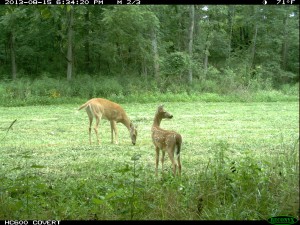Which doe do I shoot?
Which doe do I shoot?
After deer get above 6.5, I don’t trust my teeth aging skills at all, and I’m not going to guarantee that I’m not off by a year either way up to that point. At the same time, I do keep history on live bucks, but don’t try to on does. there’s one I named Hook Nose Kate that was apparently born with a birth defect that messed up her nose bad. I’ve got a pretty good idea on her, but, outside of cases like that, the rest are loosely classified and recorded as “fawn, 1.5, 2.5, mature and old (projecting somewhere over 6.5).” I can say that the lactation rates between mature and old tend to be pretty close, with the old group typically having a slight edge. I tend to believe that the “old dry doe” is more myth than reality. I’m not saying it never happens, ever, but nothing close to as many as some hunters claim.
In fact, old does tend to be the most productive at repopulating areas. They have had more years of experience in raising fawns and it shows with the edge in lactation rates. Sure, because their bodies have been beat up over the years, they may be more prone to dumping twins and singles, when they really get up there, as opposed to the occasional triplet or twins that a 3.5-6.5 tend to birth. They’re just better at protecting their fawns from predation and such. Kicking triplets is great, but does no good when 2 of them are taken out by predators and the third is abandoned (though abandonment happens far more with the fawns from year and 2 year old mothers).
How we can use this is in areas where we’re trying to raise deer numbers. Obviously, it’s best in those situations not to shoot any does. However, if you are going to shoot a doe, make it a young one without fawns. Killing a doe with fawns anywhere in the Midwest or points north is extremely rarely an issue for the fawns, as they are old enough to survive without the birthing doe. I can count on 1 hand the number of fawns I’ve seen that are still nursing during hunting season. Unfortunately, their chances of surviving winter are very poor. The reason you want to target the young does without fawns is because they either lost their fawns or they have yet to fawn for the first time. Either way, they are inexperienced mothers and odds say their next spring’s fawns face lower odds of survival than that mature or old doe’s fawns…Just another way of playing odds.
On the flip side, if you’re trying to drop deer numbers, all else being equal, you’re better off targeting mature does with twins or trips (if they’re nubbin bucks, even better). The fawns will be fine. It’s just that she is apparently productive and skilled in rearing fawns.
I know I dumped more info than you were asking, but see below for why.
Thanks tooln. I’ll try. Questions help a ton, in that they give me new directions to branch off to and reminds me that I haven’t covered this or that yet.


